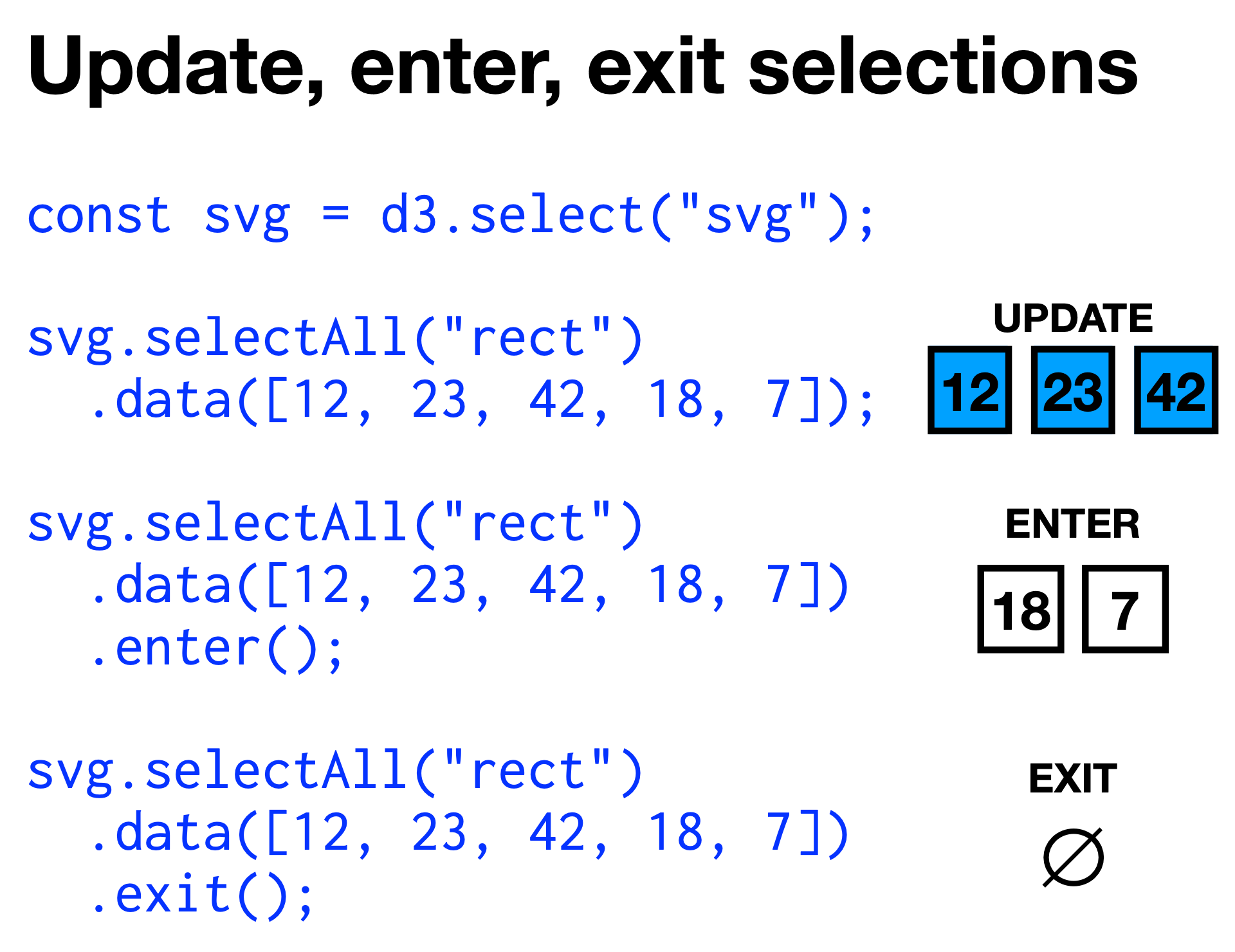D3 Bind Data
.data(data)binds data to the selected elements.dataonly accepts an array of values;.data(2)will not bind the data- if multiple elements are selected,
datacan be an array of values .data()shows the data
.datum(datum)binds a datum to all the selected elements- every selected element will get the same datum
- the datum can be a scalar
2 - or it can be an array, then every selected element will get the same array
Binding data to elements using d3 will not make explicit changes to the element: the data will not show up in the DOM.
Update, Enter, Exit
.data() will return an update, an enter, and an exit selection
- update selection contains the DOM elements that match the data
- update selection is stored in the
_groupsattribute of the return, which is the default object on which further actions will apply
- update selection is stored in the
- exit selection contains the DOM elements that don't find data matches
- exit selection is stored in the
_exitattribute of the return; you can get it using method.exit()- then
_groupsof the return of.exit()will be the exit selection
- then
- matched element in the update selection will be empty in the exit selection
- exit selection is stored in the
- enter selection contains non-existent "placeholder" elements for data that don't find object matches
- enter selection is stored in the
_enterattribute of the return; you can get it using method.enter()- then
_groupsof the return of.enter()will be the exit selection
- then
- matched element in the update selection will be empty in the enter selection
- you can add real elements to the placeholder elements by
selection.enter().append()
- enter selection is stored in the

Creating Elements Using Data
Suppose we have an empty svg element and an array of data. We want to create three rectangles inside of the svg with the data.
const specialdata = [75, 150, 200];
d3.select("svg")
.selectAll("rect")
.data(specialdata)
.enter() // placeholder elements
.append("rect") // change/append placeholder elements with rectangles
.attr("x", d => d)
.attr("y", d => d)
.attr("width", "50")
.attr("height", "30")
.attr("fill", "pink");
Create a Bar Chart
let bardata = [300, 100, 150, 225, 75, 275];
svg = d3.select("body")
.append("svg")
.attr("width", "700")
.attr("height", "400");
let bars = svg.selectAll("rect")
.data(bardata);
bars.enter()
.append("rect")
.attr("x", 0)
.attr("y", (d, i) => i * 25 + 10)
.attr("width", d => d)
.attr("height", "20")
.attr("fill", "pink");
Merge
The above examples manipulate the update, enter, and exit selection respectively.
To do some manipulations on the broader selection after some manipulations on some selection, we can use the .merge(other_selection) function.
For example:
const newdata = [123, 52, 232, 90, 34, 12, 189, 110];
const svg = d3.select("svg");
const circ = svg.selectAll("circle")
.data(newdata);
circ.enter() // 2 placeholders
.append("circle") // placeholders -> circles
.attr("cx", "100") // acts on enter selection only
.attr("cy", (d, i) => (i - 5) * 50)
.attr("r", "20")
.attr("fill", "red")
.merge(circ) // merge circ(update) into circ.enter
.transition()
.duration(2000)
.attr("cx", "200");
Combine with a function:
function changedata(data) {
const bars = d3.select("svg#gup")
.selectAll("rect")
.data(data); // bars is the update selection
bars.enter()
.append("rect")
.attr("x", "30") // until merge, acts on
.attr("y", (d, i) => i * 50) // enter selection only
.attr("height", "35")
.attr("fill", "lightgreen")
.merge(bars) // merge in the update selection
.attr("width", d => d); // acts on all bars
bars.exit()
.remove();
}
The above function works no matter if bars.enter() or bars.exit() is empty.
Groups
We can manually create groups by creating a parent element <g> for that group. For example:
const svg = d3.select("svg");
const specialdata = [100, 250, 300];
const bars =
d3.select("svg")
.append("g") // group parent element
.attr("id", "rects")
.selectAll("rect") // rects in the group g
.data(specialdata)
.enter()
.append("rect")
.attr("x", d => d)
.attr("y", d => d)
.attr("width", "50")
.attr("height", "30")
.attr("fill", "red");
 by zcysxy
by zcysxy